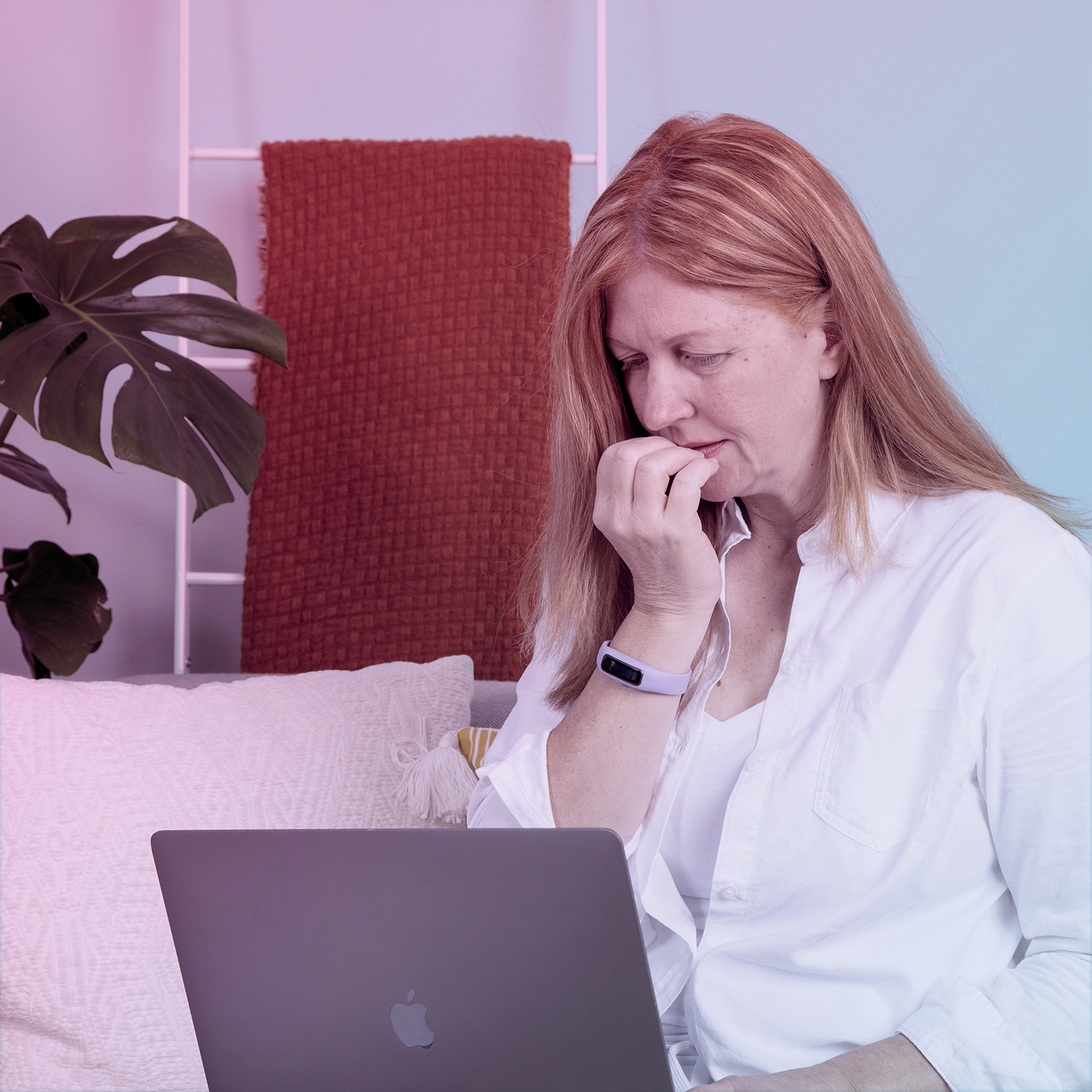It’s “Back to School” time, but school is NOT the only place learning happens. As many of you pack your suitcases for college – or trash bags as I once did – or pack your backpacks for elementary, junior or high school, remember that LIFE is going to be your best teacher.
Today, our Keen family member, Amber Bodeur, shares how her trichotillomania life helped her learn the greatest lesson of all: love is all that matter – and that loves starts with YOU.
And, of course no, “Back to school” blog is complete without a true nod to returning to class, so Amber has also graciously included tips for all y’all heading back to college!
Thank you Amber, I truly believe you’ve unlocked key secrets to treating trichotillomania!
love + awareness,
Aneela & the HabitAware team

Relapse: A Lesson in Learning to Love & Accept Me
by Amber Bodeur
In January 2017, after six years of picking at my split ends and two years of pulling out my hair, I finally told my parents about my compulsions to pull out hair from my scalp. It took them about a week or two to do some research and understand that this was not just “wanting” to pull out my hair, but “not being able to stop” pulling. My parents understanding meant a lot to me. For the first time, I believed I could actually stop! This “embarrassing” habit of mine had a name – trichotillomania, researchers that studied people like me, and tons of ways to stop were listed both online and in the several books my father ordered home. I was going to be cured!
“This was not just “wanting” to pull out my hair, but “not being able to stop” pulling!”
Not. Instead, I spent all of 2017 trying different psychologists, psychiatrists, medication, fidget toys, crazy diets, several supplements, homeopathic strategies, Keen bracelets that alerted when I raised my hand, band-aids on the fingers, breathing techniques, meditation, hypnosis, special shampoos, different hairstyles, hats, bandanas, sticker charts, support groups, and so much more. Unfortunately, there is no one magical cure, no one treatment for trichotillomania or dermatillomania.
Fortunately, a combo of these can help you make progress – and shift your mindset.
This year, I attended my first TLC Foundation for BFRBs Conference in San Francisco. It was life-changing. Every single person I met at the conference mentioned something that helped them in some way. Since there is no known cure for any of the BFRBs, it is important to find a way to cope with the disorders. An older woman mentioned her acrylic nails while a younger girl I met told me that horseback riding helped her.
As a content contributor and editor for news sites and video blogger on YouTube, what truly helped me was sharing my story. A few weeks after the conference, I shared my trichotillomania story on SpoiledNYC. Until the story was published, not even my coworkers I sat with knew about my disorder. I watched them read it with their mouths wide open followed by a storm of questions.
Due to the shame, guilt, and disgust/disappointment I felt about myself, I stopped making YouTube videos, going to the gym, and hanging out with my friends and family. No matter how many times I told myself “those people love me for me, not the amount of hair on my head,” deep down, I didn’t even like myself.
Nevertheless, I persisted, and continued to share my story and open up about BFRBs. I could not believe how many people I knew either had a BFRB themselves or knew someone with it! With an estimated 2 in 50 people, it wasn’t a huge surprise.

After sharing my story, I encouraged the members of the support group I lead in Connecticut to open up to a family member or close friend because of the positive experience I had. Knowing that even one person understands what you’re going through is such an incredible feeling.
Gaining Keen Awareness
During my “coming out” time, I felt unbelievably liberated. My biggest secret was accepted and understood by the best friends and family I could ask for. I no longer felt alone and isolated. This massive weight had been lifted off my shoulders and it felt amazing.

For the first time in my life, I believed I could stop this. I could beat trich! I began to research and started preparing myself both mentally and physically for this goal. Weirdly, when I thought about a pull-free life, I did not really want to stop pulling. Trich was my best friend and I couldn’t imagine life without it. I simply did not want to give up on pulling out my hair. I was absolutely addicted. “The way I feel about my hair is the way an alcoholic must feel about alcohol,” I thought. Unfortunately, my hair was always there with the raise of a hand, which definitely did not help much.
“With Keen, I was able to recognize where and when I pulled…Taking note of each vibration, I noticed a pattern.”
Over the next few weeks, I made some major changes. I met with my psychiatrist every week, changed my diet, stayed on top of supplements, journaled, wore my Keen bracelet, worked out twice a day, and kept my hands busy. With Keen, I was able to recognize where and when I pulled. By identifying the feelings, situations, and locations that increased my urges, I began avoiding those triggers and trying to change my atmosphere. As a writer and video editor, I am often very focused on a piece or project I am working on. A few times, my Keen bracelet alerted me during the moments I was fully-concentrated. I was shocked to find that my hand had wandered up without me noticing. I had no idea I even pulled mindlessly. Taking note of each vibration, I noticed a pattern. When I was “idling,” my left hand reached up and began to search through the strands behind my ear. For a few weeks, I got my gentle vibration reminder while I waited in line, stopped at a traffic light, waited for something to load, watched TV, sat in a waiting room, etc. Anytime I felt under-stimulated, I got urges. Since recognizing the situations I felt under-stimulated and pulled in, I began to avoid some of those situations and used strategies to “ride out” the urges in others.

< Ready for positive change? Order Keen, The Awareness Bracelet today>
Riding it Out with “Beads for BFRBs”
In order to keep my fingers busy, I started making beaded bracelets. While making one, I got the idea to sell them through Instagram. I ended up making an Instagram page, @beadsforbfrbs. 50% of the Beads for BFRBs proceeds go to The TLC Foundation, which has no doubt changed my life forever. I have only sold about 50 bracelets through online orders, but have met so many lifelong friends through this little hobby of mine.
57 days!

57 days! I went an entire eight weeks and one day without pulling a single strand of hair after a CBT session with my psychiatrist.
Of all those dream-like 57 days, the 50th was surreal. It was June 13th. I was on top of the world. My phone blew up with encouraging and supportive congratulatory messages from friends and family. Everyone that knew about my disorder and the effects it had on me understood how much this success meant to me. During my support group’s June meeting, I shared techniques and ideas that helped me. They couldn’t believe I had been over 50 days pull-free. As my father took a picture of me between the silver “5” and “0” foil balloons, I believed this was the moment I worked so hard to get to. I wore the biggest smile all day.
A Life-Long Lesson: Learning to Love Myself
On the 58th day I pulled. I was crushed, absolutely crushed. That relapse wrecked me. I completely lost control. I felt that I had disappointed everyone who worked so hard on me selflessly; my dad who did endless research, my mom who worked day and night and paid for treatment, my psychiatrist who listened, my friends who supported me through it all, and most painful of all… my BFRB friends. They looked up to me. I felt like I let them all down.
I knew I had trichotillomania for a reason. I had a purpose. I needed to stay strong through it. In that moment, I decided to be positive. I did not feel bad for myself. I did not isolate myself from the world. I did not give up. I appreciated the 57 days without shoulder and elbow pain, finger calluses, and scalp soreness.
It’s okay to pull a strand a day. It’s also okay to pull 300 strands a day. What’s not okay is beating yourself up over the control you have over your BFRB.
< See how others are taking control of nail biting, skin picking and hair pulling: Reviews from the Keen Family >
I can finally say that I have accepted my BFRB. I have made my peace with my pulling. Fully accepting my trichotillomania has actually reduced my pulling. When we don’t allow ourselves something, we want it more. It’s like those crazy diets where you’re prone to crashing in the end. Instead of convincing myself that “this is the last strand,” I allow myself to pull and that has made all the difference. Yes, I pull my hair out here and there, but it no longer defines me. I am so much more than my BFRB.
Accepting your BFRB is not an overnight decision. It’s a way of life. It takes patience, self-love, support, and perseverance. I am still learning to love myself and accept my trichotillomania every single day.
***
Taking Control at College
As many of us head away to college this fall, I made list of 5 things I wish I knew or did when I was a freshman-junior in college. As I enter into senior year, I feel hopeful and confident – a feeling that is all new to me.
Here are 5 things about college that have helped me accept my BFRB & I hope will help you too!:
-
No one really knows what they’re doing. Sure, it may seem like everyone is managing the stress, being away from home, and relationships well, but in reality everyone is freaking out just as much as you are. It’s okay to not have your major figured out. It’s okay that your paper is due in two days and all you’re doing is stress-cleaning. It’s okay to see everyone posting about their cool new internship on Facebook when you haven’t even thought about it. You are fine. Everything will be okay.
-
Everyone has “something.” With BFRBs, it’s normal to feel alone. Not many people with trichotillomania, dermatillomania, or nail biting announce they have it to every person they meet. You may feel like you’re the only person with “something,” but really everyone has something going on! “How many people know you have trichotillomania?” I thought in class one day. Every single person is going through something that isn’t visible to those around them. Your professor may have a heart condition while the funny girl sitting next to you may have lost her father in an accident and you wouldn’t even know it. Everyone is dealing with their “something” whether it’s visible or not.
-
It’s okay to get up and leave class. You’re an adult now. You pay to attend college. If you suddenly start having a pulling/picking episode in a 3-hour lecture, get up and walk out. Go wet your hair, look for a friend, grab some food, or do a minute of jumping jacks/high knees if no one is around. Changing your environment and shifting your attention is so important in coping with BFRBs.
-
Stand up for yourself. Yes, there are still bullies in college. There will continue to be bullies in the workplace and throughout our lives. I have personally been made fun of in front of the class for pulling out my hair. It hurt more than they could have imagined. However, I found that each time I didn’t go to the bathroom to cry and explained what BFRBs are, I not only made them feel terrible but also taught one more person about what they are!
-
It’s okay to get help. Dealing with BFRBs in college is not any easier than dealing with it back home or after college. It can feel uncontrollable and never-ending. There are counselors at school to help you. Please reach out to them. They will be able to talk to your professors and come up with a plan for you whether it means extended time on some assignments, being able to take a triggering class (we all have one of those!) online, or one-on-one time with your professor.
Here’s to the lessons you learn! Have a great school year!
~Amber



